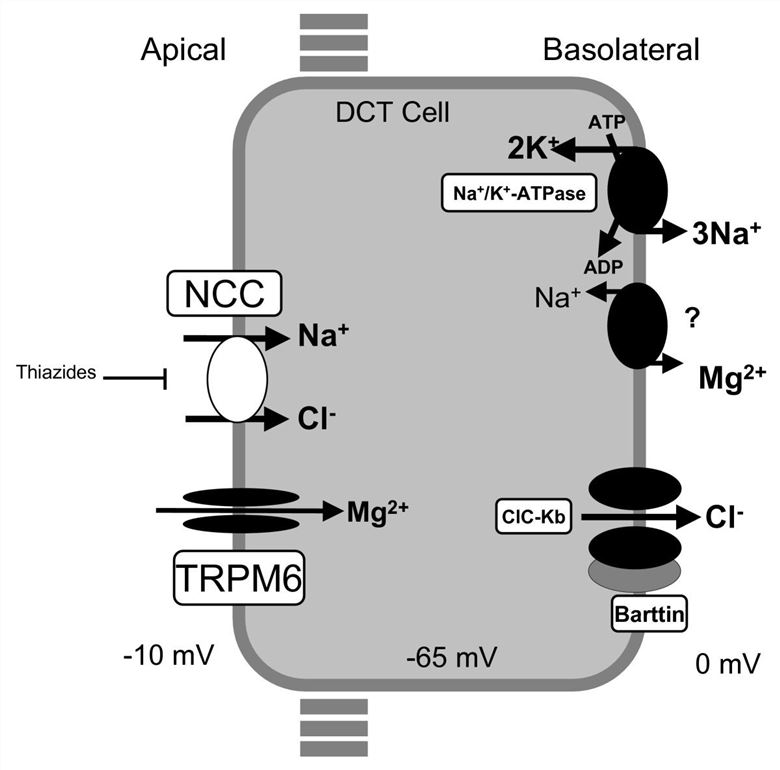Solute carrier family 12 member 3 (also known as Na+-Cl- cotransporter, NCC or NCCT, or as the thiazide-sensitive Na+-Cl- cotransporter or TSC) is a cotransporter in the kidney with the function of reabsorbing sodium and chloride ions from the tubular fluid into the cells of the distal convoluted tubule of the nephron. It is a member of electroneutral cation-coupled chloride cotransporters. In humans, it is encoded by the gene SLC12A3 located in 16q13. Once the expression of NCC is restrained, it will result in Gitelman syndrome, an autosomal recessive disease characterized by salt wasting and low blood pressure, hypokalemic metabolic alkalosis, hypomagnesemia, and hypocalciuria. There are over a hundred different mutations in the NCC gene.
| Basic Information of SLC12A3 | |
| Protein Name | Solute carrier family 12 member 3 |
| Gene Name | SLC12A3/NCC/TSC |
| Aliases | Na-Cl cotransporter(NCC), Na-Cl symporter, Thiazide-sensitive sodium-chloride cotransporter |
| Organism | Homo sapiens (Human) |
| UniProt ID | P55017 |
| Transmembrane Times | 12 |
| Length (aa) | 1021 |
| Sequence | MAELPTTETPGDATLCSGRFTISTLLSSDEPSPPAAYDSSHPSHLTHSSTFCMRTFGYNTIDVVPTYEHYANSTQPGEPRKVRPTLADLHSFLKQEGRHLHALAFDSRPSHEMTDGLVEGEAGTSSEKNPEEPVRFGWVKGVMIRCMLNIWGVILYLRLPWITAQAGIVLTWIIILLSVTVTSITGLSISAISTNGKVKSGGTYFLISRSLGPELGGSIGLIFAFANAVGVAMHTVGFAETVRDLLQEYGAPIVDPINDIRIIAVVSVTVLLAISLAGMEWESKAQVLFFLVIMVSFANYLVGTLIPPSEDKASKGFFSYRADIFVQNLVPDWRGPDGTFFGMFSIFFPSATGILAGANISGDLKDPAIAIPKGTLMAIFWTTISYLAISATIGSCVVRDASGVLNDTVTPGWGACEGLACSYGWNFTECTQQHSCHYGLINYYQTMSMVSGFAPLITAGIFGATLSSALACLVSAAKVFQCLCEDQLYPLIGFFGKGYGKNKEPVRGYLLAYAIAVAFIIIAELNTIAPIISNFFLCSYALINFSCFHASITNSPGWRPSFQYYNKWAALFGAIISVVIMFLLTWWAALIAIGVVLFLLLYVIYKKPEVNWGSSVQAGSYNLALSYSVGLNEVEDHIKNYRPQCLVLTGPPNFRPALVDFVGTFTRNLSLMICGHVLIGPHKQRMPELQLIANGHTKWLNKRKIKAFYSDVIAEDLRRGVQILMQAAGLGRMKPNILVVGFKKNWQSAHPATVEDYIGILHDAFDFNYGVCVMRMREGLNVSKMMQAHINPVFDPAEDGKEASARVDPKALVKEEQATTIFQSEQGKKTIDIYWLFDDGGLTLLIPYLLGRKRRWSKCKIRVFVGGQINRMDQERKAIISLLSKFRLGFHEVHILPDINQNPRAEHTKRFEDMIAPFRLNDGFKDEATVNEMRRDCPWKISDEEITKNRVKSLRQVRLNEIVLDYSRDAALIVITLPIGRKGKCPSSLYMAWLETLSQDLRPPVILIRGNQENVLTFYCQ |
As SLC12A3 is a protein existed in the apical membrane of the distal convoluted tubule of the nephron, it faces the lumen of the tubule and is in contact with the tubular fluid. The sodium-chloride symporter acts as a transporter of Na+ and Cl- from the tubular fluid into these cells by using the sodium gradient across the apical membrane of the cells in the distal convoluted tubule. Then the Na+ will be pumped out of the cell and comes into the bloodstream by the Na+-K+ ATPase and the Cl- leaves the cells through the basolateral chloride channel ClC-Kb. It has been reported that NCC influences this process in two control mechanisms. As NCC has to be at the plasma membrane to function, its activity can be regulated by increasing or decreasing the amount of protein at the plasma membrane. Some NCC modulators may regulate the amount of NCC at the cell surface by inducing the insertion or removal, respectively, of the protein from the plasma membrane. Moreover, many residues of NCC can activate or inhibit NCC uptake of Na+ and Cl−. Other NCC modulators can regulate NCC activity by phosphorylating conserved serine/threonine residues. NCC activity can be inhibited by thiazides.
 Fig.1 A model of transport mechanisms in the DCT. (Knoers, 2008)
Fig.1 A model of transport mechanisms in the DCT. (Knoers, 2008)
This article suggests that Gitelman syndrome (GS), salt-losing tubulopathy characterized by hypokalemic metabolic alkalosis with hypomagnesemia and hypocalciuria, is caused by inactivating mutations in the SLC12A3 gene that encodes the thiazide-sensitive sodium-chloride cotransporter (NCC) and is recessively inherited. The author finds that the single nucleotide polymorphism (SNP) detected along the SLC12A3 gene is homozygous with the notion of consanguinity.
The results demonstrate the importance of SLC12A3 polymorphisms in individuals' difference about their serum lipid profiles, thereby providing evidence that the genetic variants may contribute to CVD development via modulating person's LDL-C level and blood pressure, in certain contexts.
The findings show that the Arg913Gln variation in SLC12A3 is associated with the risk of increased blood pressure and urinary albumin excretion rate (UAER). Hence, SLC12A3- Arg913Gln variation can be regarded as a promising marker for prediction of the development and progression of diabetic nephropathy(DN)- end-stage renal disease (ESRD) in Chinese T2DM patients undergoing hemodialysis.
Their study highlights the dominant-negative effect of NCCSV on T55 and T60 phosphorylation and NCC activity. The authors reveal a new function of NCCsv in humans that broadens the understanding of NCC regulation in blood pressure control.
The results concluded that the polymorphisms of rs11643718 locus in SLC12A3 gene is associated with the susceptibility for essential hypertension among ethnic Koreans from Mudanjiang area and can be considered as a predictor for the disease.
Membrane protein studies have got great progress over the past few years. Based on our versatile Magic™ membrane protein production platform, we can provide a series of membrane protein preparation services in reconstitution forms as well as multiple active formats for worldwide customers. Besides, aided by our versatile Magic™ anti-membrane protein antibody discovery platform, we also provide customized anti-SLC12A3 antibody development services.
During the past years, Creative Biolabs has successfully generated many functional membrane proteins for our global customers. It’s our pleasure to boost the development of our clients’ programs with our one-stop, custom-oriented service. For more detailed information, please feel free to contact us.
Reference
All listed services and products are For Research Use Only. Do Not use in any diagnostic or therapeutic applications.